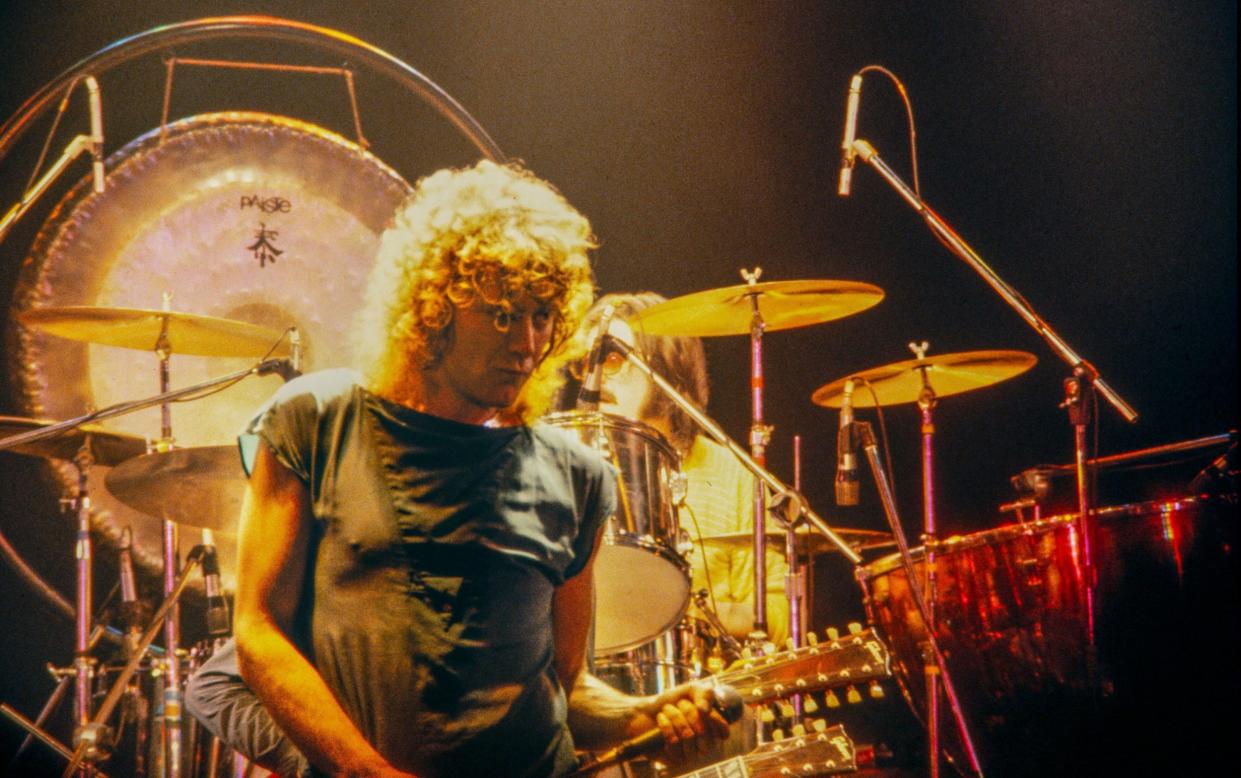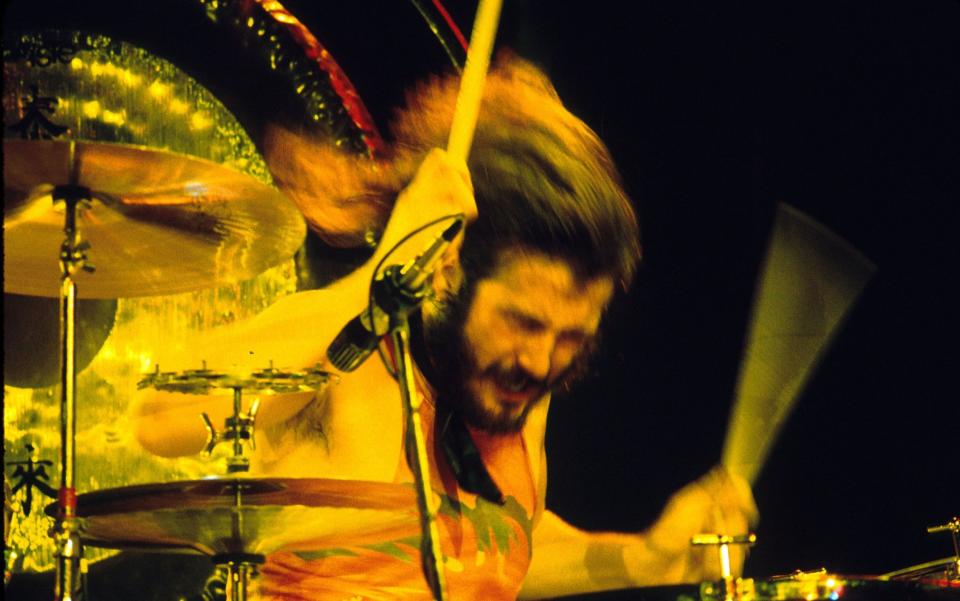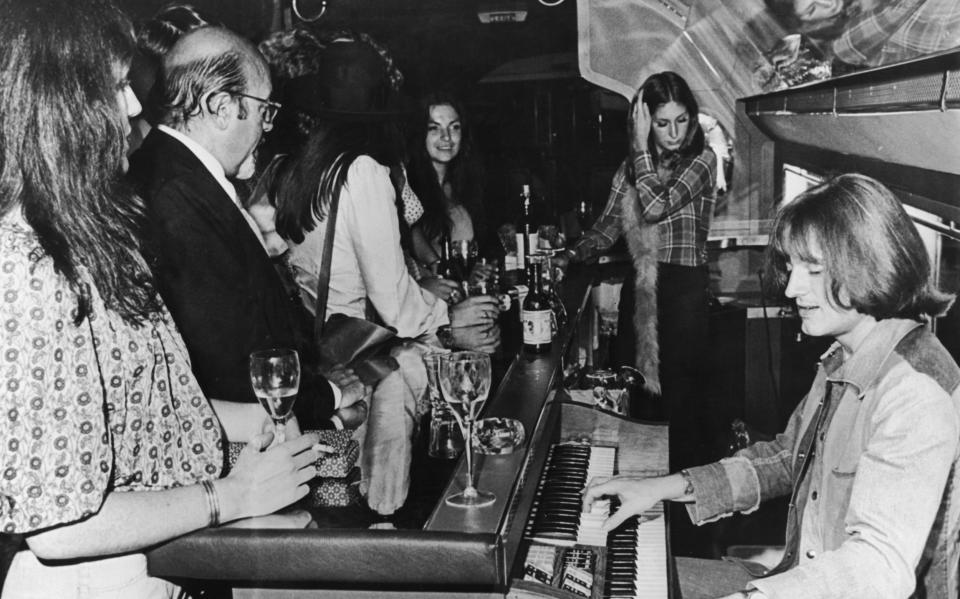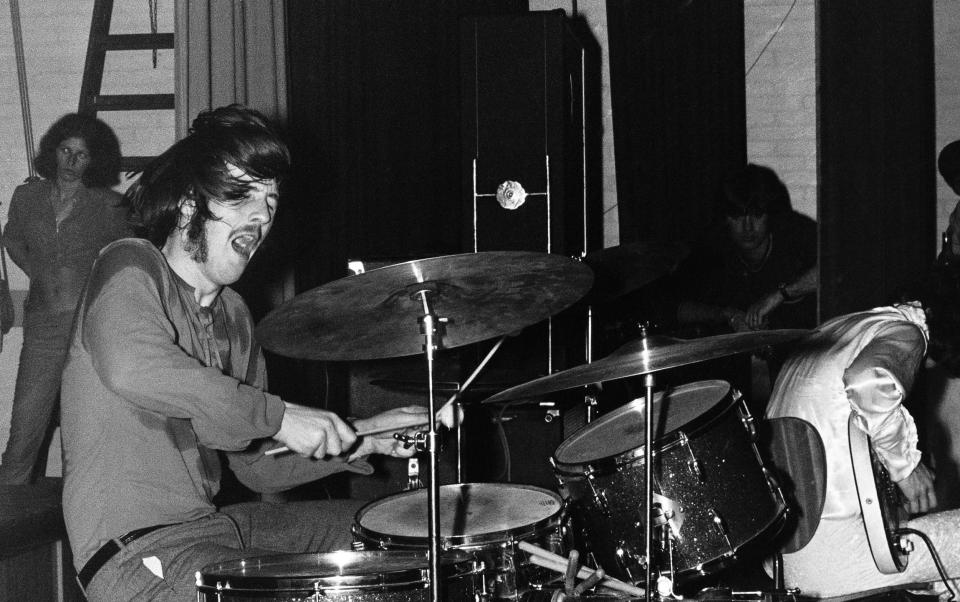‘A sweet, cuddly, goofy fella – until he got drunk’: How Led Zeppelin lost John Bonham

On January 23 1975, on a frigid noon-time day, John Bonham sat in the back of a stretch Cadillac limousine drinking vodka from the bottle. Following the completion of Led Zeppelin’s three-night stand at the Chicago Stadium the previous night, the group’s next gig, in St Louis, had been cancelled because singer Robert Plant had fallen ill.
Aboard the band’s private jet, “the Starship”, lively discussions were soon to commence as to where its passengers might be spirited for an unexpected 48-hour holiday. Bassist John Paul Jones fancied the Caribbean, while guitarist Jimmy Page hoped to go to LA. Their drummer, meanwhile, was in no doubt about where he wanted to be.
“What the f___ am I doing here?” Bonham asked on the ride to O’Hare Airport. “I wanna be back home.”
July 7 marks the anniversary of the last time John Henry Bonham played live with Led Zeppelin. Less than three months after the group’s final concert with their original line-up, at the Eissporthalle in West Berlin, one of most revered, and most unstable, drummers in rock history died on September 25, 1980 at Jimmy Page’s Berkshire home after a day of very heavy drinking. He was 32 years old.
In 1975, as the Good Ship Zeppelin flew west towards Los Angeles, the travelling party were able to content themselves that “Bonzo” had retreated to a bed at the rear of the plane to sleep off his latest jag. The mood was lightened further after iron-fisted tour manager Richard Cole learned from the journalist Chris Charlesworth, who had travelled in Bonham’s limousine, that the drummer hadn’t thought to mix his vodka with a fistful of pills.

Such was the mood of uncommon conviviality, in fact, that after lunch and several drinks, John Paul Jones began playing a selection of music hall standards on an organ attached to the bar amidships. At full volume, Peter Grant, the group’s fearsome manager, began bellowing the words to Any Old Iron.
And then…
“Bonzo, forgotten amid the festivities, emerges from the bedroom dressed only in a loosely-fitting bathrobe, lurches drunkenly into us and, without even having been introduced, attempts to do something very rude with one of the stewardesses,” Charlesworth recalled. “He is probably three times her bodyweight. She screams. Grant and Cole wrench Bonzo away from the distressed girl and lead him struggling back towards the bedroom. The girl continues screaming. A pilot appears, demanding to know what is happening. I walk away. The pilot is very angry. The girl is sobbing now, but while Grant re-emerges and assures him that everything is under control, Page leads the unfortunate girl off towards a couch where he soothes her with practised platitudes. Calm ensues.”
That this squalid tale remained untold for almost 30 years can be explained by what happened next. “The remainder of the journey passes in silence,” Charlesworth said, “except for when Cole comes down to where [the press] are sat. He doesn’t smile. ‘I don’t want to see one f______ word of this finding its f______ way into your f______ magazines. Right?”
To put it gently, Led Zeppelin occupied a world of normalised dysfunction. By 1975, certainly, the band’s entourage of minders and thugs understood that keeping the group’s four members cossetted and indulged was their sole duty. Equal part psychopath and mother-hen, Peter Grant travelled with a large briefcase stuffed with scores of thousands of dollars with which to pay, or to bully, his way out of tight spots. Following a gig at the Greensboro Coliseum, in North Carolina, mere days after John Bonham’s sexual assault, the group’s manager threatened to steal a fleet of limousines damaged by ticketless fans after their drivers (who had downed tools) refused to sell them to him for $40,000 each. “You’ll be sorry, you c____,” was his warning.
In America, at least, Led Zeppelin lead a carnival of craziness from the off. During a maiden visit to Boston, for example, in January 1969, the clamour from the crowd at the Tea Party club was such that the band were required to return to the stage in order to play their box-fresh eponymous debut album in full for a second time, before returning (for their own safety, it is said) for a further hour-long set of cover versions cobbled together in the dressing room. From sea to shining sea, they were like rocket fuel for an audience captivated by feral energies. In Beantown, within seven months, Led Zeppelin were headlining the 16,000 capacity Boston Garden.

In his exceptional book, Led Zeppelin: The Biography, the author Bob Spitz astutely noted that at the Tea Party, the band “were still in the dating phase, still getting to know one another, still developing a camaraderie. They’d only been a unit for slightly more than four months, assembled by Jimmy Page, the way a cook might choose ingredients for a recipe. Page and John Paul Jones had known each other as journeymen session players on the London studio circuit; Robert Plant and John Bonham were mates from the Midlands. Though no one would admit it, a whiff of the North-South divide lingered in the air.”
For his part, John Bonham was the group’s homebody. According to many, his antics on the road were the result of boredom and the pang of missing his wife Pat and their two children. In what might just be regarded as a foretaste of trouble to come, he had to be persuaded to even join Led Zeppelin in the first place. He was already making good money in the clubs and pubs of the West Midlands; there was talk of offers to play the drums with either Joe Cocker or the rock and blues singer Chris Farlowe. The idea of throwing in his lot with a start-up operating out of London seemed like more trouble than it was worth.
As a member of Led Zeppelin, though, he made history as the co-author of steamrolling successes that managed to outfox a media establishment well used to determining whether or not music-makers found an audience. Famously, the band didn’t bother with singles, while the press was treated with (at best) suspicion. In commercial terms, it simply didn’t matter that their reviews were often sniffy and dismissive.

Thing was, the critics simply couldn’t understand that the band’s young fans were all about Led Zepplin’s “electronic bedlam,” as one critic put it. In fact, they couldn’t get enough of it. The compellingly depraved behaviour that attended this surplus of wild electricity might not have been a coincidence.
Hazy but uniform recollections of the period speak of a culture of violence and intimidation, of pianos launched out of eighth floor hotel suites, of alcoholism and drug addiction, and of sexual alliances with young women who were children in the eyes of the law. Along with a briefcase stuffed with cash, Peter Grant travelled with a bag filled with cocaine from which party favours were doled out to all sundry on a spoon one onlooker described as “a ladle”.
In the thick of it all stood John Bonham, the band’s Dr Jeckyll and Mr Hyde. Lost as a lamb and ticking like a time bomb, the drummer was described by the writer Pamela Des Barres as “a sweet, cuddly, goofy fella until he got drunk and then you wanted to avoid him. I saw him slug my friend Michelle… right in the jaw just for being in the doorway with him at the Rainbow [in Los Angeles]”. Another associate likened him to “a schizophrenic animal, like something out of Straw Dogs”.
The drugs weren’t an enormous help, either. “Taking cocaine just enabled Bonham to drink more,” opined the music journalist Nick Kent in Barney Hoskyns’s masterful oral history Trampled Under Foot. “The combination of cocaine and alcohol is almost as dangerous as heroin. It was like [members of the group’s entourage would say], ‘Whatever you do, don’t let him do smack. He’ll snort the whole gram and overdose.’”
Despite the best efforts of everyone involved, the very idea that actions could be decoupled from consequences was just a noisy illusion. In point of fact, life was keeping score. The band and their entourage were running up quite the tab. Such was the state of ever increasing cocaine-paranoia, in fact, that journalists boarding the Starship during the notoriously ugly US tour of 1977 were presented with a document itemising the rules of engagement for anyone who found themselves in the orbit of Led Zeppelin.
It read: “1. Never talk to anyone in the band unless they first talk to you. 1A. Do not make any sort of eye contact with John Bonham. This is for your own safety. 2. Do not talk to Peter Grant or Richard Cole – for any reason. 3. Keep your cassette player turned off at all times unless conducting an interview. 4. Never ask any questions about anything other than music. 5. Most importantly, understand this – the band will read what is written about them. The band does not like the press, [and] nor does it trust them.”

The career of Led Zeppelin can be split more-or-less cleanly into two parts. Prior to the release of the double-album Physical Graffiti, in February 1975, the group’s extra-curricular activities were a mere side dish to the music. After this, though, with crashing inevitability, the chaos of it all began to gain an upper hand that was never relinquished.
Writing in the New Yorker, the critic James Wood correctly observed that “it all went properly rancid during the tours of 1975 and 1977. Page was lost to drugs; Bonham was uncontrollable. The shows were hazardous, gigantic, brilliant, careless. Page seemed not to notice or care that his guitar was out of tune. In 1975, Bonham played the drums with a bag of coke between his legs; in 1977, he fell asleep over his kit. Crowds became riotous. The Detroit Free Press called the fans, ‘the most violent, unruly crowd ever to inflict themselves on a concert hall.’” (Here, “concert hall” is quite the understatement. In the Motor City, Led Zeppelin played at the 75,000-capacity Pontiac Silverdome.)
In other words, you can have your great music, and you can have your eye-popping stories – and you can even have both at the same time. But not for long, you can’t. It doesn’t matter how good you are, soon enough (and likely much sooner than you might think) a decision has to be made as to which of these you wish to prioritise.

The beginning of the end was appropriately ugly. Following a disagreement involving John Bonham at the Day On The Green festival, at the Oakland Coliseum in the summer of 1977, Jim Matzorkis, a member of promoter Bill Graham’s security team, was beaten bloody by Peter Grant and yet another violent sidekick. With Graham seething over the assault on both person and turf, this would be the last time Led Zeppelin swaggered onto a stage in the United States of America. Worse still, in the three years preceding their disbandment in the wake of John Bonham’s death, the group performed live just 18 more times.
For lesser acts, that might well have been that. But in the 21st Century, with what looks like minimal exertion, Led Zeppelin are somehow even more popular than they were in the Seventies. The announcement in 2007 of a gig at the O2 Arena, in honour of the late Atlantic Records executive Ahmet Ertegun, saw 20 million people apply for just one of 20,000 tickets. Keeping the beat that night was John Bonham’s son, Jason, whom the group’s fans had first seen playing drums as a seven-year old in the 1976 concert film The Song Remains The Same.
With this, the juggernaut at last came to a stop. From first to last, Led Zeppelin had a Bonham in their ranks.

 Yahoo News
Yahoo News 
